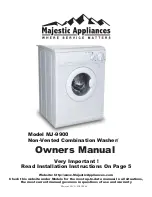
Safety
Page EN-9
the appliance so that the curvature
always remains above the waterline.
■
Do not submerge the end of the hose
in the pumped out water.
■
If the appliance is located in a room
susceptible to frost, the water in the
appliance can freeze in below-zero
temperatures. For this reason, drain
away the leftover water if there is a
risk of frost to avoid damage to the
appliance.
■
Never attempt to open the door with
force during or at the end of a cycle.
The door is automatically released af-
ter a certain time and can be opened
effortlessly.
Improper cleaning of the appliance can
cause damage to it.
■
Never use harsh, granular, soda, acid,
solvent-based or abrasive cleaners.
They can damage the surfaces or
make the rubber sleeve brittle and
fragile. All-purpose cleaners with a
neutral pH are recommended.
■
Do not use pointed, sharp or angular
objects for cleaning the rubber sleeve.
They can make the rubber sleeve
leaky.
■
Check and clean fi lters and gaskets
regularly.
■
Replace defect fi lters and gaskets im-
mediately. Never operate the appli-
ance without fi lters and gaskets or if
the fi lters and gaskets are defective.
■
Never spray the appliance with a wa-
ter jet or a high-pressure cleaner.
Improper fi lling of the appliance can
lead to damage.
■
Make sure that there are no foreign
objects in the pockets of garments in
the laundry, e.g. needles, nails, coins,
matches, staples, clips, etc.
■
Only use dyeing or bleaching agents that
are suitable for washing machines.
■
Only use tap water for washing.
■
Never try to open the appliance door
with force whilst a cycle is in progress
or once a cycle has ended. Only open
the appliance door once it has been
released automatically.
















































